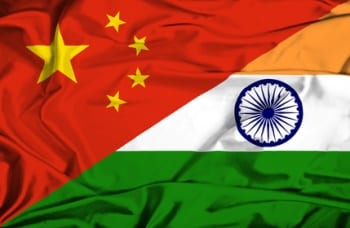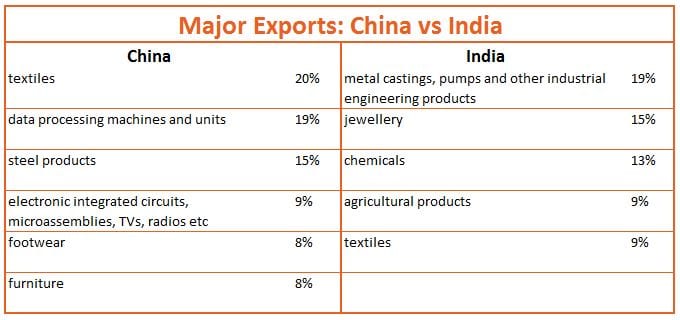 Anyone sourcing from Asia should be aware of ‘Made in China 2025‘ and the ‘Make in India’ campaign. But to source your product, you need more than government-level campaigns. How do you make the right decision for you? What are the factors in your ‘China vs India’ decision?
Anyone sourcing from Asia should be aware of ‘Made in China 2025‘ and the ‘Make in India’ campaign. But to source your product, you need more than government-level campaigns. How do you make the right decision for you? What are the factors in your ‘China vs India’ decision?
Labour Costs
It’s well known that labour costs in China are rising.
Bloomberg reports that the average hourly wage in Indian manufacturing is US$0.92. In China it’s US$3.52.
On labour cost alone, India should beat China every time. But it’s not that simple.
First up, wages vary dependent on the type of manufacturing.
Compare manufacturing exports of the two countries.
China has a lot of hi-tech manufacturing. This requires more skilled workers. So costs are higher.
Productivity matters, too. It takes 1.6 times as many worker hours to produce goods in India. So you pay a lower hourly rate, but for more hours.
Adjust for productivity and Chinese labour costs are only around twice those of India.
That’s still significant, of course. But cost of labour isn’t the only factor in the China vs India debate.
Labour Laws and Business Regulatory Environment
‘Simultaneously the most crippling of Indian diseases and the highest of Indian art-forms.’
That’s how Shashi Tharoor describes bureaucracy in ‘The Great Indian Novel‘.
The World Bank’s ‘Ease of Doing Business’ ranking tells the same story. China ranks 90th out of 189 countries. India ranks 142.
To be fair, this ranking is for setting up a business, not sourcing product. But it includes some key factors.
- Getting credit. This is the only factor where India ranks above China. 36 vs 71. That’s reflected in payment terms too. A deposit of 30% is standard when sourcing from China, but many Indian suppliers accept a 30 day payment term.
- Trading across borders. A score of 98 for China vs India at 126. Also, much Indian manufacturing is for the domestic market, whereas many Chinese factories target export markets. (And if you source via Hornet, we”l consider that when selecting a supplier.) So your Chinese supplier is more likely to export, plus the regulation is simpler.
- Enforcing contracts. China ranks 35 – ahead of the US at 41! India ranks a shocking 186 out of 189. If anything goes wrong, you don’t want to be dealing with the Indian legal system!
One more thing about Indian regulation. Labour laws and taxes are tougher for companies with over 10 employees. There’s little incentive to expand. So two thirds of manufacturing employees work for companies with 10 or fewer staff.
What does this mean for sourcing from India?
- Supplier selection is more complex and time-consuming.
- One supplier may not be able to handle a large volume.
- Smaller companies often have limited resources and can be less stable.
Companies of under 10 employees exist in China too. But there’s no artificial limit, so the range of company sizes is more balanced. In Hornet’s experience, it’s easy to find the right size supplier for your project.
Infrastructure
 Chinese government support has also led to good infrastructure.
Chinese government support has also led to good infrastructure.
Transport
Chinese cities and industrialised regions have excellent road networks. 2013 figures show China has 74,000 km of expressways. India has around 600km. The Indian government is investing in infrastructure, but major improvements will take time.
This paper on time efficiency at ports globally confirms that Chinese ports operate at world class efficiency. Indian ports need an extra day on average to process a ship.
Power
In developed countries, we take our power supply for granted. In India, that’s not so.
 A 2013 report by the Federation of Indian Chambers of Commerce and Industry details the problem.
A 2013 report by the Federation of Indian Chambers of Commerce and Industry details the problem.
- 5% of firms suffer 21-30 hours per week of power shortage.
- 21% suffer more than 30 hours per week.
- 64% feel erratic power supply affects their competitiveness.
- 61% would pay more for reliable power supply.
In the same year, China State Grid reported that ‘nationwide power supply reliability was up to 99.948%.’
Supply Chain Clusters
Finally, strong supply chains exist in many parts of China. Cities or regions have developed a manufacturing speciality and related businesses cluster close together. Short supply chains mean less material in transit, so less overhead cost. There’s also less risk of delay when demand spikes suddenly.
In conclusion
When Hornet started out a decade or more ago, China was the obvious choice for Asian sourcing. The challenge was quality, not cost. Now the picture is more complex.
Quality manufacturers exist in China. But it’s still inconsistent. It’s important to audit factories carefully and ensure proper quality control measures. On the other hand, China is no longer the default option for low cost. (Despite the recent devaluation of the yuan!)
At Hornet, we’ve investigated other Asian countries, including India. We’ve sourced from India. So far, it’s been textiles and clothing. We’ve experienced many of the issues described above. We haven’t opened any offices yet – we worked with carefully selected partners to test the water. We continue to monitor the Indian market.
In many ways, India in 2015 is like China when we started out. Costs are low, but you need strong quality control. And structural factors like transport and power cannot be controlled. Any international sourcing leadtime should include a buffer. In China, you may need that buffer. In India, you will!
The decision whether to source from China or India depends on your specific project. Ask yourself these questions.
- What product do you want? In what volume?
- How much lead-time do you have? What will be the impact of a delay?
- What’s your quality standard? How much tolerance do you have for variation? (It’s not just precision electronics vs clothing. Quality for luxury retail clothing is not the same as for a give-away t-shirt.)
We hope this article gives a good background on the China vs India sourcing debate. For a detailed discussion of your project, please contact us.

